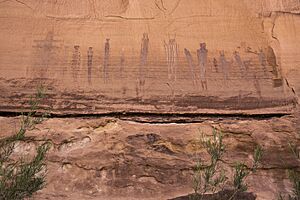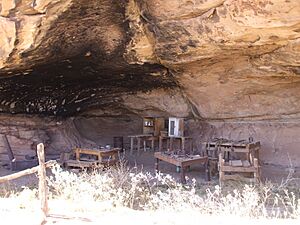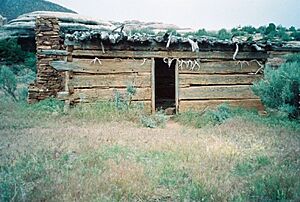National Register of Historic Places listings in Canyonlands National Park facts for kids
Canyonlands National Park in Utah is a truly amazing place, full of incredible landscapes and ancient history. But did you know it's also home to many important historical sites? These special spots are listed on the National Register of Historic Places. This is like a national list of places that are super important to American history and culture.
When a place is on this list, it means it's recognized for its historical value and efforts are made to protect it. In Canyonlands National Park, there are 11 different places and areas that have earned a spot on this important list. These sites tell us stories about the people who lived here long ago, like ancient Native Americans, and also about cowboys and explorers from more recent times.
Contents
Historic Places in Canyonlands
Canyonlands National Park protects many different types of historic sites. These include old camps, rock art, and even trails and bridges. Each one helps us understand the past of this unique area.
Ancient Rock Art and Shelters
Many of the oldest historic sites in Canyonlands are places where ancient people left their mark. These include rock shelters and amazing drawings on canyon walls.
Cowboy Rock Shelter Site
This site is a rock shelter that shows signs of being used by people a very long time ago. Its exact location is kept secret to help protect it from damage.
Harvest Scene Pictograph
This is a special rock art panel that shows a scene that looks like a harvest. It's a pictograph, which means it was painted onto the rock. These paintings give us clues about the daily lives and beliefs of the ancient people who lived here. The exact location of this site is also kept private to protect it.
Horseshoe (Barrier) Canyon Pictograph Panels
One of the most famous rock art sites in Canyonlands is in Horseshoe Canyon, also known as Barrier Canyon. Here, you can find incredible pictograph panels, including the "Great Gallery." These paintings feature large, mysterious figures that are thousands of years old. They are a powerful reminder of the ancient cultures that once thrived in this region. To keep these delicate artworks safe, their precise location is not shared publicly.
Salt Creek Archeological District
This large area along Salt Creek contains many different ancient sites. It's like an outdoor museum, showing us how people lived, hunted, and gathered food in this canyon for thousands of years. Because it's such an important and sensitive area, its exact location is also restricted.
Historic Camps and Inscriptions
Other historic sites in Canyonlands tell stories of explorers, cowboys, and other people who passed through or lived in the area more recently.
Cave Springs Cowboy Camp
Located in the Needles district of the park, this site was once a camp for cowboys. They used places like this when they were herding cattle in the vast, open lands of Utah. It gives us a peek into the life of a cowboy in the American West.
Kirk's Cabin Complex
This site includes an old cabin and other structures used by early settlers or ranchers. It's a reminder of the hardy people who tried to make a living in this challenging environment.
Lost Canyon Cowboy Camp
Similar to Cave Springs, this was another camp used by cowboys. These camps were essential for cowboys as they moved their herds across the rugged landscape of Canyonlands.
Neck and Cabin Springs Grazing Area
This area was historically used for grazing livestock, meaning animals like cattle or sheep would feed on the plants here. It shows how people used the land for ranching, which was an important part of the economy in this region.
Denis Julien Inscription (San Juan County, Utah)
Denis Julien was an early explorer and fur trapper who traveled through this area in the 1800s. He left his name carved into the rock, which is called an inscription. These inscriptions are like historical graffiti, showing where explorers passed through.
D.C.C. & P. Inscription "B"
This is another historic inscription found in the park. Inscriptions like these are valuable because they provide direct evidence of early visitors and their journeys through Canyonlands.
Kolb Brothers "Cat Camp" Inscription
The Kolb Brothers were famous photographers who explored the Grand Canyon and other parts of the Colorado River. They also left an inscription in Canyonlands at a place they called "Cat Camp." Their inscriptions are a link to the early days of river exploration and photography in the American West.
Historic Trails and Bridges
Some historic sites are not just places, but also routes or structures that helped people travel through the park.
Murphy Trail and Bridge
The Murphy Trail is a historic trail that winds through the rugged terrain of Canyonlands. It includes a bridge that was built to help people cross difficult sections. This trail was important for accessing different parts of the park and is a testament to the engineering skills of the past.
Images for kids













